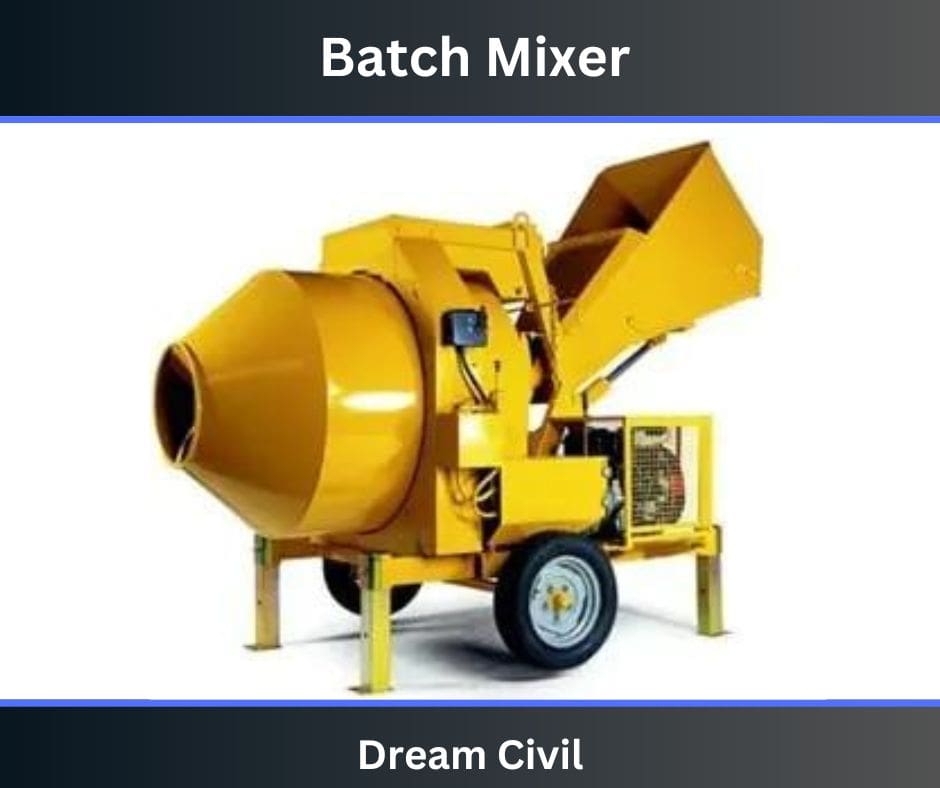Table of Contents
A machine that is used to have a homogeneous mix of cement, sand, and aggregate in a specified grade is known as a Concrete Mixer machine.
There are different types of concrete mixer machines available in the market of different brands.
1. Concrete Mixer Machine
The machine layout is made of mixing drums, feeding devices, unloading mechanisms, water supply systems, prime mover, and transmission mechanisms.
The machine primarily enables the collision between particles and the development of dispersion. Usually, this machine has three primary units:
a. Feeding unit
b. Mixing unit
c. Discharge Unit
2. Types of Concrete Mixer Machine
a. Based on Working Principles
i. Batch Mixer
ii. Continuous Mixer
b. Based on Mixing Methods
i. Self Loading Mixer
ii. Compulsory Mixer
c. Based on the shape of concrete mixers
i. Pear-Shaped Mixer
ii. Drum Shaped Mixer
iii. Cone Shaped Mixer
iv. Vertical Shaft Pan Mixer
v. Horizontal Shaft Mixer
d. Based on the Discharging Method
i. Rotary or Non-tilting Type
ii. Tilting Type
e. Commonly Used
i. Forced Mixer
ii. Self Propelled Mixer
i. Batch Mixer
Batch mixers are machined in which measured ingredients are kept, blended, and released as one mass. This is different from a continuous mixer, where materials are provided into the machine frequently, making an endless supply of the outcome.

Properties:
a. Contains exceptionally high ability (batches of up to 1 thousand gallons or 3785 liters).
b. Consists of drum mixers, pan mixers, and open-top mixers.
c. Different types of batch mixers (e.g. Gravity, revolving drum, cube, etc).
d. Gravity mixers are made fixed.
e. Revolving mixers include shelves and projections on the inside and the drum is rotated to combine the materials.
ii. Continuous Concrete Mixer
Continuous mixers are machines in which ingredients are delivered uniformly and discharge occurs as a steady stream. The loading of materials is accomplished regularly by screw feeders.

Properties:
a. More productivity than the batch mixer.
b. Material proportion and mixing time are challenging to manage.
c. Feeding, mixing, and discharging functions go on in a longer mixing drum constantly.
iii. Self-Loading Concrete Mixer
Self-loading mixers are those which can automatically create and transport concrete on-site.

Properties:
a. Efficient as they can pack them themselves (Don’t require any Additional equipment!).
b. Good for a little and small construction.
c. Four-wheel drove, low pressures and wide tires, swing rear axles (provides good off-road performance).
d. Motor and hydraulic system and electronic weighing system.
e. Include a rotating drum attached to an operator-driven cab-mounted chassis frame equipped with a loading bucket.
f. This type of mixer is excellently fitted for sites where concrete batching plants are not obtainable.
iv. Compulsory Concrete Mixer

Properties:
a. Elements of twin-shaft required mixer: Mixing device, reducer, shaft-end sealing, electric lubricating oil pump, discharging system.
b. Provided with a floating oil sealing ring at each end axis.
c. Full automatic system.
d. Eccentric double seal design in hopper gate.
e. The disc vertical axis caused concrete mixer can be categorized into two types:
Turboprop type and Planetary type.
v. Rotary or Non-Tilting Type Concrete Mixer
Rotary mixers are not permitted to lean but operate drum rotation about their horizontal axis for releasing concrete mix.

Properties:
The drum is opened at two sides where one end is for streaming and the next end is for release.
Rapid discharge is not feasible which may result in the segregation of concrete a few times.
vi. Tilting Type Mixer
The tilting type mixer is a mixer with a rotating drum to release the concrete mix.

Properties:
a. Mixes the ingredients while forward rotating and discharge downwards rapidly employing gravity switching the mixer drum.
b. Employed to mix plastic and semi-dry concrete.
c. Low noise, stable operation, and convenient movement.
d. Combining efficiency relies on the shape of the drum, angle of the drum, size, and angle of blades.
vii. Forced Concrete Mixers
Forced mixers are specially for hard concrete, lightweight aggregate, and liquid concrete. This is specially employed in the concrete batching plant. The machine is specially developed to mix gravel and resin smoothly and uniformly.

Properties:
a. Have stirring blades equipped on the spindle arms.
b. The disc vertical axis forced mixer can be divided into two types:
Turboprop type and Planetary type.
viii. Self Propelled Concrete Mixers
Properties:
a. Contain stirring blades ranged vertically on the inside wall of the mixing drum.
b. The drum revolves horizontally when provided materials are raised and materials fall down due to gravity.

ix. Pear-Shaped Mixer

Properties:
This is a self-loading concrete mixer.
x. Drum Shaped Mixer
Properties:
This is a self-loading concrete mixer.

xi. Cone Shaped Mixer
Properties:
This a self-loading concrete mixer.

xii. Vertical Shaft Pan Mixer

Properties:
a. This is a Compulsory Concrete Mixer.
b. It is not only used in standard or precast concrete but also in high-performance concrete.
c. Includes the frame, stirring cover, follow-up paddle, cylinder, lifting slider mechanism, electric part, etc.
d. There is a circular pan where concrete is combined and blades are placed in a star shape inside the pan.
xiii. Horizontal Shaft Mixer

Properties:
a. This is a Compulsory Concrete Mixer.
b. Due to its horizontal design, the paddle mixer can easily mix a series of a wide range of aggregates, especially the massive ones to create a more uniform slurry.
c. The best option for lightweight as well as dry hard concrete.
3. Concrete Mixer Machine Price
The concrete mixer machine’s price is Rs 1.2 lakh Indian rupees.
The small concrete mixer machine’s price is 66000 Indian rupees.

4. Uses of Concrete Mixer Machine
The uses of concrete mixer machines are as follows:
i. Used to mix cement, sand, and aggregate.
ii. Provides require grades of the mix.
iii. Used to save a lot of time.
iv. Used where manpower is less.
5. References1. Content Filter & Authenticity Checking Team, Dream Civil International (Our team checks every content & detail to maintain quality.) |
Read Also: Geocell in Road Construction

